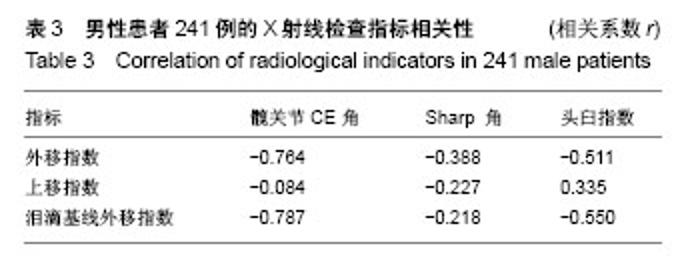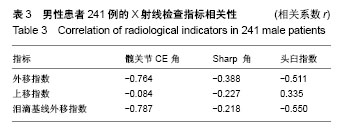| [1] Cao L, Tan L, Lin X, et al. Reconstruction mode selection of acetabular bone defect and effect on acetabular cup position in cementless total hip arthroplasty. Zhongguo Xiu Fu Chong Jian Wai Ke Za Zhi. 2015; 29:693-699.[2] Domb BG, Stake CE, Lindner D, et al. Arthroscopic capsular plication and labral preservation in borderline hip dysplasia: two-year clinical outcomes of a surgical approach to a challenging problem. Am J Sports Med. 2013;41:2591-2598.[3] Kanawade V, Dorr LD, Wan Z. Predictability of acetabular component angular change with postural shift from standing to sitting position. J Bone Joint Surg Am. 2014;96:978-986.[4] Derbyshire B. Correction of acetabular cup orientation measurements for X-ray beam offset. Med Eng Phys. 2008;30:1119-1126.[5] Di Schino M, Baudart F, Zilber S, et al. Anterior dislocation of a total hip replacement. Radiographic and CT-scan assessment. Behavior following conservative management. Orthop Traumatol Surg Res. 2009;95:573-578.[6] Krepler P, Vana N, Havranek C. Dosimetric studies in the radiological examination of the hips in young infants with a special fenestration method of gonad protection. Pediatr Radiol. 1977;5:231-235.[7] Lequesne MG. Femorocoxometry: angles and segments characteristic of dysplastic and dysmorphic hip conditions in adult. Measurement using a femorocoxometer for standard or reduced (digitized) films. Rev Rhum Engl Ed. 1999;66:136-142.[8] Kobayashi N, Inaba Y, Yukizawa Y, et al. Bone mineral density distribution in the proximal femur and its relationship to morphologic factors in progressed unilateral hip osteoarthritis. J Bone Miner Metab. 2015;33:455-461.[9] Ancelin D, Reina N, Cavaignac E, et al. Total hip arthroplasty survival in femoral head avascular necrosis versus primary hip osteoarthritis: case-control study with a mean 10-year follow-up after anatomical cementless metal-on-metal 28-mm replacement. Orthop Traumatol Surg Res. 2016;102:1029-1034.[10] Davis RL 2nd, Samora WP 3rd, Persinger F, et al. Treatment of unstable versus stable slipped capital femoral epiphysis using the modified dunn procedure. J Pediatr Orthop. 2017. doi: 10.1097/BPO.0000000000000975.[11] Liu Y, Sun J. Analysis of outcomes of one-stage operation for treatment of late-diagnosed developmental dysplasia of hip. Zhonghua Wai Ke Za Zhi. 2017;55:228-232.[12] Lidder S, Heidari N, Gansslen A, et al. Radiological landmarks for the safe extra-capsular placement of supra-acetabular half pins for external fixation. Surg Radiol Anat. 2013;35:131-135.[13] Rudert M, Holzapfel BM, Pilge H, et al. Partial pelvic resection (internal hemipelvectomy) and endoprosthetic replacement in periacetabular tumors. Oper Orthop Traumatol. 2012;24:196-214.[14] Bonin SR, Lanciano RM, Corn BW, et al. Bony landmarks are not an adequate substitute for lymphangiography in defining pelvic lymph node location for the treatment of cervical cancer with radiotherapy. Int J Radiat Oncol Biol Phys. 1996;34:167-172.[15] Crowe JF, Mani VJ,Ranawat CS. Total hip replacement in congenital dislocation and dysplasia of the hip. J Bone Joint Surg Am. 1979; 61(1):15-23.[16] Chahal J, Van Thiel GS, Mather RC 3rd, et al. The patient acceptable symptomatic state for the modified harris hip score and hip outcome score among patients undergoing surgical treatment for femoroacetabular impingement. Am J Sports Med. 2015;43: 1844-1849.[17] Li Z. Minimally invasive closed reduction and internal fixation with fully threaded headless cannulated compression screws for repair of distal radius fracture: study protocol for a randomized controlled trial. Clin Transl Orthop. 2016;1:58-63.[18] Wu T, Zhang GQ. Minimally invasive treatment of proximal humerus fractures with locking compression plate improves shoulder function in older patients: study protocol for a prospective randomized controlled trial. Clin Transl Orthop. 2016;1:51-57.[19] Yin PB, Long AH, Shen J, et al. Treatment of intertrochanteric femoral fracture with proximal femoral medial sustainable intramedullary nails: study protocol for a randomized controlled trial. Clin Transl Orthop. 2016;1:44-50. |

